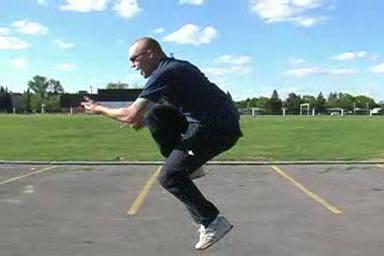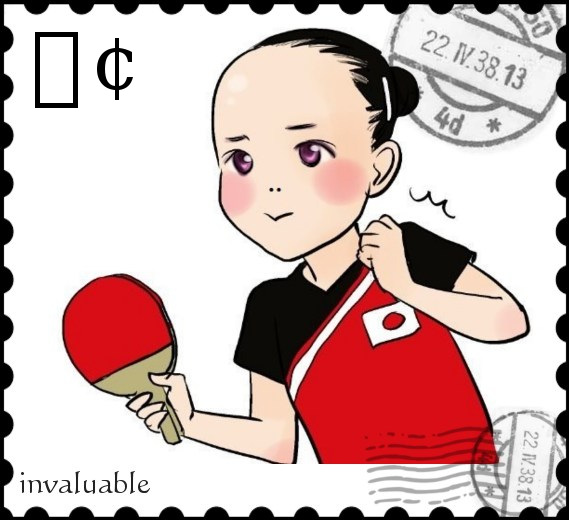|
|
|
Concave vs. Convex Loop (Which is which/better?) |

|
Post Reply 
|
Page <123> |
| Author | ||||||
pnachtwey 
Platinum Member 
Joined: 03/09/2010 Location: Vancouver, WA Status: Offline Points: 2035 |
 Post Options Post Options
 Thanks(0) Thanks(0)
 Quote Quote  Reply Reply
 Posted: 06/24/2012 at 2:13pm Posted: 06/24/2012 at 2:13pm |
|||||
The brachistochrone works because the brachistochrone allows the ball to drop or accelerate faster initially. This isn't the case with a swing that opposes gravity. I know where you are going with this. You are thinking of the brachistochone with a upwards swing where the swing starts out shallow to get moving and then starts in the upwards direction. Good one, but if the paddle attitude is always changing the resulting timing errors will result in poor control. However, if the paddle attitude can be kept constant during the up swing it may work. The big question is will this make any practical difference? Most of us can swing far faster than what is necessary anyway. |
||||||
 |
||||||
| Sponsored Links | ||||||
 |
||||||
zeio 
Premier Member 
Joined: 03/25/2010 Status: Offline Points: 10833 |
 Post Options Post Options
 Thanks(0) Thanks(0)
 Quote Quote  Reply Reply
 Posted: 06/24/2012 at 1:52pm Posted: 06/24/2012 at 1:52pm |
|||||
|
I am getting there.
Forget the maths and the gravity. The keyword here is time. It is time, not distance, that really matters in producing the best swing. And for that to happen the best path to follow during a swing is a curve that most closely resembles the brachistochrone. Concave or convex, positive or negative, however you name it. It may sound counter-intuitive, but the longer path does produce the least time and we see signs of it in videos of the pros. And one thing is for sure, that path has never been and probably never will be a straight line as those who are in denial of any curvature in swing mechanics may have imagined. They could have been doing it all along without even realizing. The answer is out there, that the way we live, the tools we use, and the many things we come across during our lives are largely inspired by Nature. As it turns out, we humans tend to ignore it and overcomplicate things. As Johann Bernoulli himself has put it - "Nature always tends to act in the simplest way, and so it here lets one curve serve two different functions, while under any other hypothesis we should need two curves..." Edited by zeio - 06/24/2012 at 1:55pm |
||||||
|
Viscaria FL - 91g
+ Neo H3 2.15 Blk - 44.5g(55.3g uncut bare) + Hexer HD 2.1 Red - 49.3g(68.5g 〃 〃) = 184.8g |
||||||
 |
||||||
pnachtwey 
Platinum Member 
Joined: 03/09/2010 Location: Vancouver, WA Status: Offline Points: 2035 |
 Post Options Post Options
 Thanks(0) Thanks(0)
 Quote Quote  Reply Reply
 Posted: 06/24/2012 at 11:13am Posted: 06/24/2012 at 11:13am |
|||||
You can't don't sweat it.
Those that figured this problem out were the best of their time. The Timo Bolls and Ma Longs of math and physics. There I related this to TT. |
||||||
 |
||||||
mikepong 
Gold Member 

Joined: 03/09/2011 Location: Philippines Status: Offline Points: 1202 |
 Post Options Post Options
 Thanks(0) Thanks(0)
 Quote Quote  Reply Reply
 Posted: 06/24/2012 at 10:25am Posted: 06/24/2012 at 10:25am |
|||||
|
can someone correlate these math equations or whatever it is to TT? sorry not really good at math
|
||||||
|
Viscaria
FH: Tenergy 05 black BH: Tenergy 05 red |
||||||
 |
||||||
pnachtwey 
Platinum Member 
Joined: 03/09/2010 Location: Vancouver, WA Status: Offline Points: 2035 |
 Post Options Post Options
 Thanks(0) Thanks(0)
 Quote Quote  Reply Reply
 Posted: 06/24/2012 at 10:08am Posted: 06/24/2012 at 10:08am |
|||||
|
Nice, the problem can be solved symbolically and there are only 16 steps! If I had to solve that problem I would have written the differential equations and solved iteratively using RK4. That would have been a lot of work. So many problems I run into don't have a symbolic solution and the problem must be solved using brute force iteration. With a symbolic solution you have a proof. With a iterative one you don't because that works with one set if numbers. |
||||||
 |
||||||
power7 
Silver Member 
Joined: 01/25/2012 Location: USA Status: Offline Points: 745 |
 Post Options Post Options
 Thanks(0) Thanks(0)
 Quote Quote  Reply Reply
 Posted: 06/24/2012 at 9:32am Posted: 06/24/2012 at 9:32am |
|||||
|
Not really following this argument.
What aspect of a TT forehand swing is powered by gravity? So the fastest swing follows the path of a cycloid? You think any of the top TT players in the CNT can do a simple math proof... These models are not intuitive at all.
|
||||||
|
DHS PG-7, H3 Neo, 729-5
Butterfly Power-7, Red TG2 Neo 39degree, Black Donic Bluefire M1 |
||||||
 |
||||||
zeio 
Premier Member 
Joined: 03/25/2010 Status: Offline Points: 10833 |
 Post Options Post Options
 Thanks(0) Thanks(0)
 Quote Quote  Reply Reply
 Posted: 06/24/2012 at 6:56am Posted: 06/24/2012 at 6:56am |
|||||
Doesn't matter whether there is friction or not. The end result is the same. You are correct in picking the green, but you may be surprised to know that the acceleration of the ball down the path is actually constant. The mass and thus inertia of the ball also does not have any effect on its speed, as evidenced by the conservation of energy. It just so happens that the curve produces the best speed from the acceleration due to gravity. The curve seen in the image is referred as the Brachistochrone curve, which is Greek for "the shortest time." The brachistochrone curve happens to be a segment of an inverted cycloid. Before the brachistochrone was solved, the closely related Tautochrone curve, meaning "same time," was found to be part of a cycloid also. For those who are still reading: The brachistochrone problem was first posed by Johann Bernoulli, in which a point is to start from rest at point a and, solely under the effect of gravity, follow down to point b along a curve that is to be covered in the least time. Follow the second quoted passage to see the maths behind it. Equations (16) and beyond consider the condition where friction is present. The curve is slightly different as a result of that. Edited by zeio - 06/24/2012 at 7:01am |
||||||
|
Viscaria FL - 91g
+ Neo H3 2.15 Blk - 44.5g(55.3g uncut bare) + Hexer HD 2.1 Red - 49.3g(68.5g 〃 〃) = 184.8g |
||||||
 |
||||||
zeio 
Premier Member 
Joined: 03/25/2010 Status: Offline Points: 10833 |
 Post Options Post Options
 Thanks(0) Thanks(0)
 Quote Quote  Reply Reply
 Posted: 06/24/2012 at 6:47am Posted: 06/24/2012 at 6:47am |
|||||
It is obvious, isn't it? I bet he must both be kicking in his coffin and having a good laugh, to see that human nature has not changed all that much since his time. |
||||||
|
Viscaria FL - 91g
+ Neo H3 2.15 Blk - 44.5g(55.3g uncut bare) + Hexer HD 2.1 Red - 49.3g(68.5g 〃 〃) = 184.8g |
||||||
 |
||||||
hobbes203 
Member 
Joined: 04/17/2012 Location: United States Status: Offline Points: 17 |
 Post Options Post Options
 Thanks(0) Thanks(0)
 Quote Quote  Reply Reply
 Posted: 06/24/2012 at 5:20am Posted: 06/24/2012 at 5:20am |
|||||
|
@Zeio
Couldn't resist answering that question, both objects are of the same mass and has the same qualities (same kinetic and static friction, etc), and the ramps are also equivalent, then both would hit the bottom at the same time whether they slide or roll. Easiest way to do this is energy, but I'll leave it at that. The important question is what are the accelerations of the objects at the bottom? (Answer should be a vector quantity, magnitude and direction). Given a very, very general scenario, the comparison of the balls at the bottom of the ramp can be applied to the moment a table tennis ball at a fixed point is contacted by the concave and convex strokes. At this point, I won't try to get into springs, torque, friction, and the magnus effect. Generally, the ballistics of the ball is determined by the magnitude and acceleration at different contacts of a controlled ball. I'm no expert but really just try the strokes for yourself, have a robot hit one spot and hit the ball at the same spot with controlled similar-accelerated but different swings. Also
 Edited by hobbes203 - 06/24/2012 at 6:03am |
||||||
 |
||||||
popperlocker 
Gold Member 
Joined: 03/24/2008 Location: United States Status: Offline Points: 1753 |
 Post Options Post Options
 Thanks(0) Thanks(0)
 Quote Quote  Reply Reply
 Posted: 06/24/2012 at 4:34am Posted: 06/24/2012 at 4:34am |
|||||
If you've played with both a tacky chinese rubber and Tenergy 05, you will understand.
|
||||||
 |
||||||
power7 
Silver Member 
Joined: 01/25/2012 Location: USA Status: Offline Points: 745 |
 Post Options Post Options
 Thanks(0) Thanks(0)
 Quote Quote  Reply Reply
 Posted: 06/24/2012 at 2:52am Posted: 06/24/2012 at 2:52am |
|||||
|
I've had a few different coaches that span many different points in my life. PRC coaches teaches the basic FH that way. Mostly, shoulder movement. They don't say lock the elbow, but it just happens, to give more control over the ball, if you pivot with mostly shoulder movement.
Other coaches I've had never really emphasize the stroke Mechanic like that. Mostly emphasize stiff wrist for control. As for why? More powerful muscle group. Less chance of crossing body with that swing. Maybe carried over from taichi principles (guess?). But that's what PRC system teaches. Or maybe kids start so young there they need to use more shoulder to get blade over the table? Edited by power7 - 06/24/2012 at 2:59am |
||||||
|
DHS PG-7, H3 Neo, 729-5
Butterfly Power-7, Red TG2 Neo 39degree, Black Donic Bluefire M1 |
||||||
 |
||||||
V-Griper 
Silver Member 

Joined: 09/19/2011 Location: United States Status: Offline Points: 879 |
 Post Options Post Options
 Thanks(0) Thanks(0)
 Quote Quote  Reply Reply
 Posted: 06/24/2012 at 2:16am Posted: 06/24/2012 at 2:16am |
|||||
So your answer to my question is, that is what they were taught. Maybe I need to clarify my question. I understand how they got their stroke mechanics. What I want to know is why. Why use the shoulder as a pivot point instead of the elbow? If you are a coach, and you are teaching young kids how to hit the ball, why would yoou have them do it one way over another? Are they both equally valid ways of hitting the ball? What set of advantages/disadvantages are there? Edited by V-Griper - 06/24/2012 at 2:25am |
||||||
 |
||||||
power7 
Silver Member 
Joined: 01/25/2012 Location: USA Status: Offline Points: 745 |
 Post Options Post Options
 Thanks(0) Thanks(0)
 Quote Quote  Reply Reply
 Posted: 06/24/2012 at 1:33am Posted: 06/24/2012 at 1:33am |
|||||
|
Because ML elbows are at a fixed angle when he is loop driving. So the forward rotation is done with the shoulders. They are taught to use the shoulder as major pivot point of their swing, not the elbow.
TB flexes his elbow more during the swing for forward motion. That's why his stroke seems more linear in the video following the same path hitting and retracting. |
||||||
|
DHS PG-7, H3 Neo, 729-5
Butterfly Power-7, Red TG2 Neo 39degree, Black Donic Bluefire M1 |
||||||
 |
||||||
V-Griper 
Silver Member 

Joined: 09/19/2011 Location: United States Status: Offline Points: 879 |
 Post Options Post Options
 Thanks(0) Thanks(0)
 Quote Quote  Reply Reply
 Posted: 06/24/2012 at 1:18am Posted: 06/24/2012 at 1:18am |
|||||
|
Here is WLQ counter hitting. He is clearly guiding his paddle in a modified circular path. I say modified because the take back is like a semi circle but the forward part is flattened out.
Again. This time the well referenced ML slow mo FH. Similar motion. Starting from the ready position. Paddle goes down, then back beside the right knee. Then slightly up and then flattens out as it moves forward into the ball. So the question is why do a circular motion at all? Why not do more of a straight back and strait forward motion? Like this. Or this. Iwill grant you that Timo and BP are still making a slightly squashed oval, albeit slight, but it looks nothing like what WLQ and ML are doing. Some related questions- Why is ML's elbow so close to the body on the take back? why does the paddle usually stop beside the knee? Why does ML's knee seem to collapse inward slightly?(So does RSM's btw https://www.youtube.com/watch?v=RMVzq-OnBcM&feature=player_embedded)
I am interested in peoples opinions. P.S. Please refrain from playing the "Chinese vs Euro" card. It gets old. I want you guys to think not recycle arguments. Edited by V-Griper - 06/24/2012 at 1:39am |
||||||
 |
||||||
pnachtwey 
Platinum Member 
Joined: 03/09/2010 Location: Vancouver, WA Status: Offline Points: 2035 |
 Post Options Post Options
 Thanks(0) Thanks(0)
 Quote Quote  Reply Reply
 Posted: 06/23/2012 at 11:53pm Posted: 06/23/2012 at 11:53pm |
|||||
Easy. If the paddle is going to maintain the same attitude and speed during the stroke then you can't change anything until AFTER impact. After impact it is best to get back to the ready position.
Yes, but that is due to the limitations on how fast you can decelerate the paddle AFTER the impact.
I am not sure what you mean. I don't think the length of the arc has much do do with being less sensitive to the spin except for the fact it is easier to move the paddle forward faster with a bigger stroke. It requires less acceleration and deceleration. Spin causes the ball to move tangentially to the ball impact. The impact itself causes the ball to 'reflect' off the paddle. Assume the ball is hitting the paddle straight on or normal to the paddle and there is spin on it. The ball will spin off to the side at a certain rate. If if spins off to the side at the same rate it bounces back in the normal direction the ball will bounce off the paddle at an angle of 45 degrees. Now what if the ball hits with the same spin but you hit the ball so the ball is returning 10 times faster in the normal direction. Then the paddle angle will be only 5.7 degrees from normal. ATAN(normal speed/tangential speed) It is the same principle behind why faster paddles have lower 'throw angles', but it really depends on how fast you hit the ball.
No it is simple vector trigonometry.
No, it is simply that hitting the ball faster means the spin has less effect on the angle of return. If you could hit the ball infinitely fast the spin would have almost no effect on the return angle of the ball. I think there are many that intuitively realize this when they say 'hit through spin'. |
||||||
 |
||||||
IllSonny 
Super Member 
Joined: 07/24/2011 Location: Saint Paul Status: Offline Points: 191 |
 Post Options Post Options
 Thanks(0) Thanks(0)
 Quote Quote  Reply Reply
 Posted: 06/23/2012 at 10:44pm Posted: 06/23/2012 at 10:44pm |
|||||
|
I gotta say, as a rookie player, this is the most interesting thread I ever read... Sorry for the off topic post... :)
|
||||||
|
Stiga Infinity VPS Legend
H3 Galaxy Moon |
||||||
 |
||||||
icontek 
Premier Member 

This is FPS Doug Joined: 10/31/2006 Location: Maine, US Status: Offline Points: 5222 |
 Post Options Post Options
 Thanks(0) Thanks(0)
 Quote Quote  Reply Reply
 Posted: 06/23/2012 at 10:37pm Posted: 06/23/2012 at 10:37pm |
|||||
I understand what you are saying, I think... But why then does followthrough make so much difference in consistency, power and placement of a stroke? For example: Takie a mid distance BH topspin, with the backswing from the hip, rotation from the leading shoulder, and uncoiling of the core while contacting the ball in front into a big followthrough that ends with the arm high, out to the right (assuming right handed)... Why does the larger arc (relative to a smaller backswing and smaller followthrough) require less adjustment against incoming spin? In other words, why do bigger mechanics seem to ignore incoming spin more than smaller mechanics? Is it because there is a larger section of the arc where a "reasonably good shot" is possible? |
||||||
 |
||||||
BH-Man 
Premier Member 

Joined: 02/05/2007 Location: United States Status: Offline Points: 5042 |
 Post Options Post Options
 Thanks(0) Thanks(0)
 Quote Quote  Reply Reply
 Posted: 06/23/2012 at 9:06pm Posted: 06/23/2012 at 9:06pm |
|||||
Good comparison. Red ball has shorter path to go to finish and has constant acelleration if friction is a non-factor. Green ball has a longer path, but achieves higher velocity before halfway point.
|
||||||
|
Korea Foreign Table Tennis Club
Search for us on Facebook: koreaforeignttc |
||||||
 |
||||||
pnachtwey 
Platinum Member 
Joined: 03/09/2010 Location: Vancouver, WA Status: Offline Points: 2035 |
 Post Options Post Options
 Thanks(0) Thanks(0)
 Quote Quote  Reply Reply
 Posted: 06/23/2012 at 8:56pm Posted: 06/23/2012 at 8:56pm |
|||||
I think it is impossible to avoid convex or concave loops because our arm rotate around sockets. However, I I agree you are probably doing it wrong if you have much of a convex or concave loop. If your timing isn't perfect the ball will go low or high if you paddle attitude is changing during the stroke. I try to keep the attitude of my paddle constant during the time that impact can occur and my swing in a plane so that my stroke is not as timing dependent. If I hit the ball a millisecond early or late it won't make any difference. I find this thread amusing. So those of you that argue one way or another, how do you justify your statements? How can you justify the potential errors due to the ball hitting a few millisecond earlier or latter? What difference does a 0.1 degree difference in the paddle attitude make over 3 meters or more? I also know that the ball doesn't care about the stroke leading up to and after impact. Only the attitude and rate of change in attitude of the paddle make a difference as well as the stoke and rate of change in the stroke directions DURING the stroke make a difference. |
||||||
 |
||||||
V-Griper 
Silver Member 

Joined: 09/19/2011 Location: United States Status: Offline Points: 879 |
 Post Options Post Options
 Thanks(0) Thanks(0)
 Quote Quote  Reply Reply
 Posted: 06/23/2012 at 6:50pm Posted: 06/23/2012 at 6:50pm |
|||||
Sliding or rolling? Friction? Off the cuff I would say green(if they are rolling, or sliding with no friction). Larger initial acceleration(linear and rotational) in the beginning and greater momentum and inertia at the end to maintain velocity. The green ball is accelerating/moving/rolling a lot faster. You will have to explain the relevance. I don't get it.
Edited by V-Griper - 06/23/2012 at 6:52pm |
||||||
 |
||||||
vvk1 
Gold Member 

Joined: 11/14/2009 Location: UK Status: Offline Points: 1925 |
 Post Options Post Options
 Thanks(0) Thanks(0)
 Quote Quote  Reply Reply
 Posted: 06/23/2012 at 1:41pm Posted: 06/23/2012 at 1:41pm |
|||||
|
A famous English dude figured this out in 1696 :-)
|
||||||
 |
||||||
zeio 
Premier Member 
Joined: 03/25/2010 Status: Offline Points: 10833 |
 Post Options Post Options
 Thanks(0) Thanks(0)
 Quote Quote  Reply Reply
 Posted: 06/23/2012 at 1:21pm Posted: 06/23/2012 at 1:21pm |
|||||
|
For those who have chosen to jump to conclusions, I invite them to answer the following question.
Given two balls released from the top at the same time, which one reaches the bottom in the shortest time, Red or Green? Why?  |
||||||
|
Viscaria FL - 91g
+ Neo H3 2.15 Blk - 44.5g(55.3g uncut bare) + Hexer HD 2.1 Red - 49.3g(68.5g 〃 〃) = 184.8g |
||||||
 |
||||||
mikepong 
Gold Member 

Joined: 03/09/2011 Location: Philippines Status: Offline Points: 1202 |
 Post Options Post Options
 Thanks(0) Thanks(0)
 Quote Quote  Reply Reply
 Posted: 06/23/2012 at 9:57am Posted: 06/23/2012 at 9:57am |
|||||
wow thanx man, i really didnt understand what we were talking about here until i saw the illustration, and i agree that the choice of loop depends on what ball is coming to you
|
||||||
|
Viscaria
FH: Tenergy 05 black BH: Tenergy 05 red |
||||||
 |
||||||
bluebucket 
Platinum Member 
Joined: 02/20/2011 Location: 16 Status: Offline Points: 2882 |
 Post Options Post Options
 Thanks(0) Thanks(0)
 Quote Quote  Reply Reply
 Posted: 06/23/2012 at 9:44am Posted: 06/23/2012 at 9:44am |
|||||
|
There is no such thing as a convex or concave loop, if you have the spare time and muscles to make that shape movement when looping you are simply doing it wrong.
|
||||||
 |
||||||
zeio 
Premier Member 
Joined: 03/25/2010 Status: Offline Points: 10833 |
 Post Options Post Options
 Thanks(0) Thanks(0)
 Quote Quote  Reply Reply
 Posted: 06/23/2012 at 8:48am Posted: 06/23/2012 at 8:48am |
|||||
Wu Jingping's article, at the time of writing(2005 as indicated by one source), did point out that the forehand loop of Chinese penholders lacked power, a trait common among players owing to the short-pips hitter style. And so he had made it a first priority and had forced Wang Hao and Ma Lin to practice hitting harder. The notion that the Chinese hit harder probably first took root a decade ago along with Wang Liqin's first claim of the WTTC title. Duan Xiang(段翔), deputy director of R&D of the CTTA, uses the term "扭轉爆發鞭沖技術(Rotation-induced Explosion Whip-like [Forward"> Loop Technique, literally)" to separate Wang Liqin's forehand loop from the rest whom he describes as "加速制動擺沖技術(Acceleration-Braking Pendulum-like [Forward] Loop Technique)". The latter is likely an extension to the term "加速制動(Acceleration-Braking)", first coined by Zhuang Zedong, who takes a minimalistic approach to stroke mechanics where great emphasis is placed on maximizing acceleration before contact and brakes to a halt as soon as the ball takes off to reduce the time of recovery. According to Duan's words, what sets Wang Liqin apart is the unique[at that time] kinetic chain he uses to harness the rotational kinetic energy by coupling the arm, waist, crotch and so on. Edited by zeio - 06/23/2012 at 8:48am |
||||||
|
Viscaria FL - 91g
+ Neo H3 2.15 Blk - 44.5g(55.3g uncut bare) + Hexer HD 2.1 Red - 49.3g(68.5g 〃 〃) = 184.8g |
||||||
 |
||||||
king_pong 
Silver Member 

Joined: 06/29/2010 Location: Minneapolis Status: Offline Points: 889 |
 Post Options Post Options
 Thanks(0) Thanks(0)
 Quote Quote  Reply Reply
 Posted: 06/22/2012 at 6:51pm Posted: 06/22/2012 at 6:51pm |
|||||
|
Excellent point, excellent post, V-griper! Thanks. I think you're right.

|
||||||
 |
||||||
V-Griper 
Silver Member 

Joined: 09/19/2011 Location: United States Status: Offline Points: 879 |
 Post Options Post Options
 Thanks(0) Thanks(0)
 Quote Quote  Reply Reply
 Posted: 06/22/2012 at 1:37pm Posted: 06/22/2012 at 1:37pm |
|||||
|
I may be wrong but it seems to me that the the curve of the stroke, and the relatively closed or open paddle condition, is largely determined by where the ball is taken off the bounce.
If you take the ball early, anywhere up to, and including, slightly after TOB (top of bounce) and the ball is above net height, I think it would be preferable to have "positive" arc loop stroke and emphasize a relatively closed paddle face. It also facilitates over the table looping. If the ball is taken much after TOB and below net height it would then be preferable to use the "negative" arc loop stroke with a more open paddle face. The arc of the ball as it descends requires a more vertical "lifting" action. Also, of course, when you are stroking underspin. Of course each individuals adjustment is different. 
Examples- Positive arc Negative arc Edited by V-Griper - 06/22/2012 at 2:16pm |
||||||
 |
||||||
racquetsforsale 
Gold Member 
Joined: 10/02/2010 Location: at the table Status: Offline Points: 1268 |
 Post Options Post Options
 Thanks(0) Thanks(0)
 Quote Quote  Reply Reply
 Posted: 06/22/2012 at 12:57pm Posted: 06/22/2012 at 12:57pm |
|||||
|
This is what I'm referring to: Wu Jing Ping on the FH; at the end of the article, he mentions that Chinese players tend to brush more because they use tacky rubbers, as opposed to their European counterparts who drive more with their grippy and elastic rubbers. |
||||||
 |
||||||
zeio 
Premier Member 
Joined: 03/25/2010 Status: Offline Points: 10833 |
 Post Options Post Options
 Thanks(0) Thanks(0)
 Quote Quote  Reply Reply
 Posted: 06/22/2012 at 12:46pm Posted: 06/22/2012 at 12:46pm |
|||||
I can understand where racquetsforsale is coming from. Liu Guozheng has been quoted for commenting on Chen Qi having more of a wrapping motion than other players, yet he happens to generate more power than would have been thought possible. Edited by zeio - 06/22/2012 at 12:47pm |
||||||
|
Viscaria FL - 91g
+ Neo H3 2.15 Blk - 44.5g(55.3g uncut bare) + Hexer HD 2.1 Red - 49.3g(68.5g 〃 〃) = 184.8g |
||||||
 |
||||||
Imago 
Premier Member 
Joined: 07/19/2009 Location: Sofia Status: Offline Points: 5897 |
 Post Options Post Options
 Thanks(0) Thanks(0)
 Quote Quote  Reply Reply
 Posted: 06/22/2012 at 10:24am Posted: 06/22/2012 at 10:24am |
|||||
Kind of eugenic/rasist statement.
|
||||||
 |
||||||
Post Reply 
|
Page <123> |
|
Tweet
|

|
| Forum Jump | Forum Permissions  You cannot post new topics in this forum You cannot reply to topics in this forum You cannot delete your posts in this forum You cannot edit your posts in this forum You cannot create polls in this forum You cannot vote in polls in this forum |
|
Forum Home | Go to the Forums | Forum Help | Disclaimer
MyTableTennis.NET is the trading name of Alex Table Tennis Ltd. |